Entry Database : PDB / ID : 2q7lTitle The Androgen Receptor Prostate Cancer Mutant H874Y Ligand Binding Domain Bound with Testosterone and a TIF2 box3 Coactivator Peptide 740-753 Androgen receptor Nuclear receptor coactivator 2 Keywords / / / Function / homology Function Domain/homology Component
/ / / / / / / / / / / / / / / / / / / / / / / / / / / / / / / / / / / / / / / / / / / / / / / / / / / / / / / / / / / / / / / / / / / / / / / / / / / / / / / / / / / / / / / / / / / / / / / / / / / / / / / / / / / / / / / / / / / / / / / / / / / / / / / / / / / / / / / / / / / / / / / / / / / / / / / / / / / / / / / / / Biological species Homo sapiens (human)Method / / / Resolution : 1.92 Å Authors Gampe, R.T. Journal : J.Biol.Chem. / Year : 2007Title : Modulation of androgen receptor activation function 2 by testosterone and dihydrotestosterone.Authors : Askew, E.B. / Gampe, R.T. / Stanley, T.B. / Faggart, J.L. / Wilson, E.M. History Deposition Jun 7, 2007 Deposition site / Processing site Revision 1.0 Jul 24, 2007 Provider / Type Revision 1.1 Oct 23, 2007 Group Revision 1.2 Jul 13, 2011 Group / Version format complianceRevision 1.3 May 8, 2013 Group Revision 1.4 Oct 20, 2021 Group / Derived calculations / Category / struct_ref_seq_dif / struct_siteItem _database_2.pdbx_DOI / _database_2.pdbx_database_accession ... _database_2.pdbx_DOI / _database_2.pdbx_database_accession / _struct_ref_seq_dif.details / _struct_site.pdbx_auth_asym_id / _struct_site.pdbx_auth_comp_id / _struct_site.pdbx_auth_seq_id Revision 1.5 Feb 21, 2024 Group / Category / chem_comp_bond
Show all Show less
 Yorodumi
Yorodumi Open data
Open data Basic information
Basic information Components
Components Keywords
Keywords Function and homology information
Function and homology information Homo sapiens (human)
Homo sapiens (human) X-RAY DIFFRACTION /
X-RAY DIFFRACTION /  SYNCHROTRON /
SYNCHROTRON /  MOLECULAR REPLACEMENT / Resolution: 1.92 Å
MOLECULAR REPLACEMENT / Resolution: 1.92 Å  Authors
Authors Citation
Citation Journal: J.Biol.Chem. / Year: 2007
Journal: J.Biol.Chem. / Year: 2007 Structure visualization
Structure visualization Molmil
Molmil Jmol/JSmol
Jmol/JSmol Downloads & links
Downloads & links Download
Download 2q7l.cif.gz
2q7l.cif.gz PDBx/mmCIF format
PDBx/mmCIF format pdb2q7l.ent.gz
pdb2q7l.ent.gz PDB format
PDB format 2q7l.json.gz
2q7l.json.gz PDBx/mmJSON format
PDBx/mmJSON format Other downloads
Other downloads 2q7l_validation.pdf.gz
2q7l_validation.pdf.gz wwPDB validaton report
wwPDB validaton report 2q7l_full_validation.pdf.gz
2q7l_full_validation.pdf.gz 2q7l_validation.xml.gz
2q7l_validation.xml.gz 2q7l_validation.cif.gz
2q7l_validation.cif.gz https://data.pdbj.org/pub/pdb/validation_reports/q7/2q7l
https://data.pdbj.org/pub/pdb/validation_reports/q7/2q7l ftp://data.pdbj.org/pub/pdb/validation_reports/q7/2q7l
ftp://data.pdbj.org/pub/pdb/validation_reports/q7/2q7l Links
Links Assembly
Assembly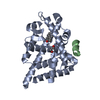
 Components
Components Homo sapiens (human) / Gene: AR, DHTR, NR3C4 / Production host:
Homo sapiens (human) / Gene: AR, DHTR, NR3C4 / Production host: 
 Homo sapiens (human) / Gene: NCOA2, TIF2 / Production host:
Homo sapiens (human) / Gene: NCOA2, TIF2 / Production host: 
 X-RAY DIFFRACTION / Number of used crystals: 1
X-RAY DIFFRACTION / Number of used crystals: 1  Sample preparation
Sample preparation SYNCHROTRON / Site:
SYNCHROTRON / Site:  APS
APS  / Beamline: 17-BM / Wavelength: 1 Å
/ Beamline: 17-BM / Wavelength: 1 Å Processing
Processing MOLECULAR REPLACEMENT / Resolution: 1.92→20.45 Å / Cor.coef. Fo:Fc: 0.966 / Cor.coef. Fo:Fc free: 0.956 / SU B: 4.131 / SU ML: 0.119 / Cross valid method: THROUGHOUT / ESU R: 0.169 / ESU R Free: 0.148 / Stereochemistry target values: MAXIMUM LIKELIHOOD / Details: HYDROGENS HAVE BEEN ADDED IN THE RIDING POSITIONS
MOLECULAR REPLACEMENT / Resolution: 1.92→20.45 Å / Cor.coef. Fo:Fc: 0.966 / Cor.coef. Fo:Fc free: 0.956 / SU B: 4.131 / SU ML: 0.119 / Cross valid method: THROUGHOUT / ESU R: 0.169 / ESU R Free: 0.148 / Stereochemistry target values: MAXIMUM LIKELIHOOD / Details: HYDROGENS HAVE BEEN ADDED IN THE RIDING POSITIONS Movie
Movie Controller
Controller





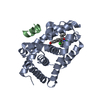
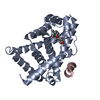

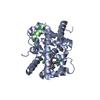
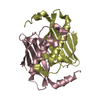

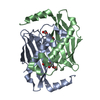
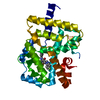

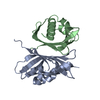
 PDBj
PDBj

















